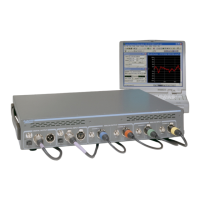§
ATS-2 can examine an AES/EBU digital interface signal and assure
the integrity of digitally transmitted data. It can also measure and
examine the jitter in the waveform. ATS-2 can extract a variety of
statistics from a digital waveform, including the sample rate, the
interface waveform voltage, the jitter amplitude, and the active and
inactive data bits. ATS-2 also has the capability of transmitting and
receiving a full complement of AES/EBU status bits.
§
ATS-2’s sample rate may be synchronized to an external AES/EBU
signal, a square wave, or an NTSC or PAL video source.
§
ATS-2 has two auxiliary control connectors for control of external
equipment.
Conceptual Architecture of ATS-2
The func tional com po nents im ple mented in ATS-2 in clude two au dio
sig nal gen er a tors, an au dio sig nal an a lyzer, dig i tal and an a log in put and
out put mod ules, and a mod ule for ex ter nal timebase synchronization.
All sig nal gen er a tion is per formed in the dig i tal do main. One of the two
sig nal gen er a tors is ded i cated to the dig i tal out put. The sig nal from this
dig i tal gen er a tor is buf fered and con di tioned for the bal anced, un bal anced
and op ti cal out puts. The out put of the sec ond sig nal gen er a tor is con -
verted to an an a log sig nal by a dig i tal-to-an a log con verter (DAC). The
two-chan nel out put of the DAC is con di tioned and ranged for the
balanced and unbalanced analog outputs.
All sig nal anal y sis is also per formed in the dig i tal do main. The dig i tal in -
put is buf fered and di rectly ap plied to the an a lyzer. An a log in puts are first
ranged and con di tioned, and then dig i tized by a high-res o lu tion an a -
log-to-dig i tal con verter (ADC) be fore be ing ap plied to the an a lyzer. An op -
tional high-band width ADC is avail able to increase measurement
bandwidth.
Conceptual Architecture of ATS-2 Chapter 1: General Information
Getting Started with ATS-2 3
Analog Domain vs. Digital Domain
Analog audio signals are electrical analogies of the sound waves
that they represent, varying in frequency and amplitude in a continuous
fashion. In analog audio electronics, these voltages and currents are
manipulated, processed, and measured by modifying their amplitude or
frequency. The term analog domain refers to signals represented and
processed in this fashion.
Digital audio signals, on the other hand, are numerical
representations of the sound waves. The representation is often carried
on an electrical signal called the interface signal. Digital audio is
processed mathematically in processes gathered together under the
name of Digital Signal Processing, or DSP. The term digital domain
refers to signals represented and processed in this fashion.

